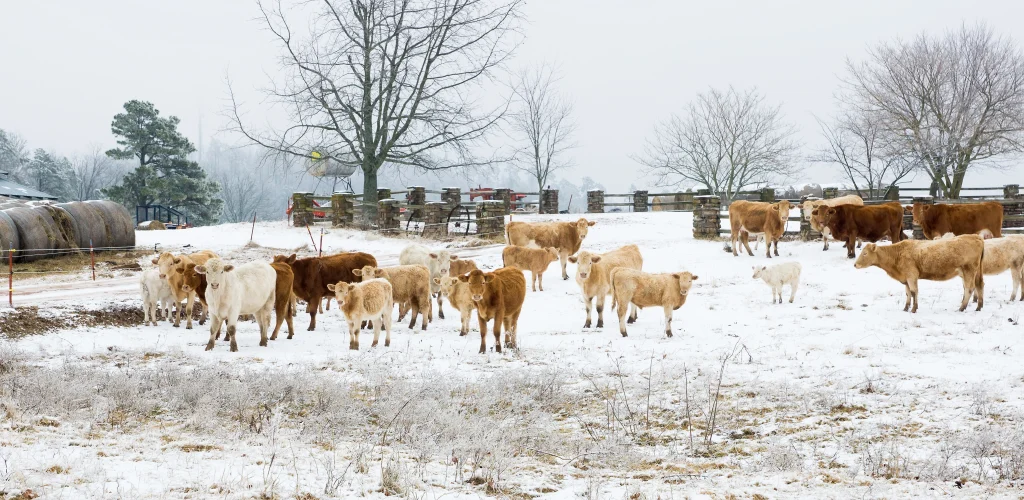Financing on Feeders also now available! Payments less than the amount of money you’ll save on Hay Costs!
On cold-weather farms, livestock face challenges beyond just snow and ice.
The freezing temperatures increase their energy requirements, limit access to pasture, and complicate water management for you.
But with a bit of know-how and some thoughtful planning, you can turn winter feeding into a season of success.

When the thermometer truly plunges, hitting what we call an animal’s lower critical temperature (LCT), their bodies kick into overdrive, burning extra calories just to stay warm. This additional demand can be as much as 10–30% higher than in warmer months.
Winter also slows down digestion and makes feed less efficient. Without proper adjustments, livestock may lose weight, produce less milk, and be more likely to get sick.
Did you know that, according to research from several land-grant universities, cattle actually require more energy when temperatures drop?
For every degree Fahrenheit below their lower critical temperature (LCT), their energy needs can go up by about 1%. So, what’s a farmer to do when the temperature drops? Below are some proven strategies to ensure your animals stay healthy, productive, and comfortable all winter long.
You should know your herd’s body condition score (BCS) before winter hits. With this knowledge, you can personalize their meal plans.
Remember, thin animals will need higher-energy diets, while those carrying a bit too much should be managed to avoid piling on more fat.
BCS checkpoints:
Adjust rations accordingly for each group based on their score and physiological needs.
This proactive approach ensures that you use your feed wisely, maintaining your animals’ productivity and health throughout the entire season.
Don’t wait until the snow falls to start thinking about forage. Late summer or early fall is the time to begin stockpiling high-quality grasses such as:
Properly managed, this stockpile can provide nutritious grazing well into the winter. You can also:
Cold weather can degrade even the best feed if it’s not stored correctly.
Tips for optimal feed storage:
And don’t forget accessibility! Clear those snow paths to feeding areas and invest in sturdy feeders that can withstand trampling and minimize waste.
Winter’s no time for a light diet! Your livestock need extra energy and protein to fight the cold.
Common options:
Remember, slow and steady wins the race. Always introduce new feeds gradually to keep their digestive systems happy.
The cold wind makes 30°F feel like 10°F for your animals as well. Without proper shelter, they expend vital calories just to stay warm instead of growing or producing milk.
The solution? Windbreaks. Your livestock naturally stay warmer, using feed to support productivity instead of just survival.
Ideas:
Well-sheltered animals eat more efficiently and convert feed into energy instead of just warmth.
If water freezes, your animals get dehydrated. A dehydrated animal is a slow, inefficient eater, which impacts their digestion and the efficiency of feed conversion.
What to do:
Water intake can decrease by up to 40% in winter if not properly managed, which can impact feed intake and productivity.
Overfeeding grain or poor-quality hay can lead to:
Always balance your rations, ideally using lab-tested forage values as your guide. Use feeders that reduce trampling and blowing.
Don’t rely on guesswork. Keep a close eye on how much each group is actually eating, and be ready to tweak things based on:
Record-keeping tools or feeding apps can be helpful in streamlining this process.
Feeding late in the day can help animals maintain body heat through the coldest parts of the night. Warm feeds also help digestion and the comfort of your animals.
Feeding time tips:
Supplements can be a valuable resource, but only when you know exactly why and how you’re using them.
Best practices:
Remember, supplements should enhance, not replace, a solid foundation in feed.
Winter livestock nutrition can become quite complex, so feel free to seek expert advice.
Benefits of consulting professionals:
The good news is that most land-grant universities and local agriculture extension offices offer this invaluable advice, often at no or very low cost.
Even experienced farmers can fall into common traps when winter hits. Knowing what not to do is just as crucial as knowing what to do for your livestock’s health and your bottom line. Some common mistakes are:
Avoiding these pitfalls ensures fewer visits to the vet and more profitability for you.
Sustainable winter feeding practices benefit not just your livestock, but your bottom line and the land you rely on. Thoughtful strategies help minimize environmental impact and reduce long-term costs.
Some Suggestions:
Yes, by testing forage, reducing waste, and precisely balancing rations, you can optimize without overspending.
Not always. It depends on forage quality and energy needs. Some animals do well on high-quality hay alone.
Ideally, between 40°F and 65°F to maintain intake and avoid gut stress.
Send the sample to a laboratory for nutrient analysis. Look for high protein and energy values with minimal mold.
Absolutely not. It increases the risk of dehydration and lowers body temperature.
It’s not always the case. Free-choice mineral blocks or tubs can be effective when there is consistent intake.
Winter doesn’t have to be a struggle. By planning ahead, closely monitoring your livestock, and adapting to daily conditions, your cold-weather farm can keep animals healthy and productive throughout the harshest months.
Use the strategies shared in this article to turn winter feeding from a burden into a season of substantial gains. Upgrade your feeding game this winter with durable, waste-reducing solutions from HayBoss Feeders. Because when your livestock thrive, your farm does too.
Powered by Prevail Marketing copyright 2025